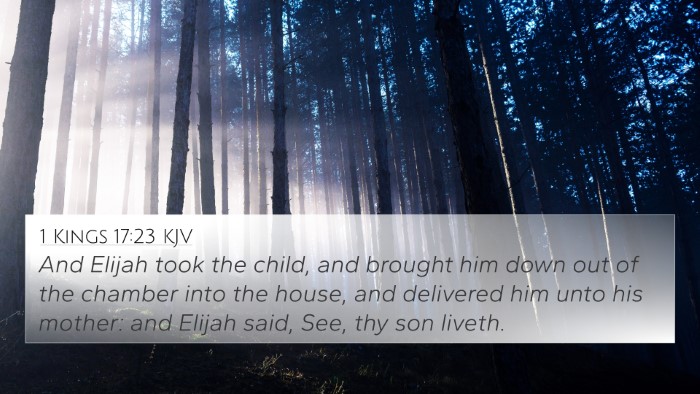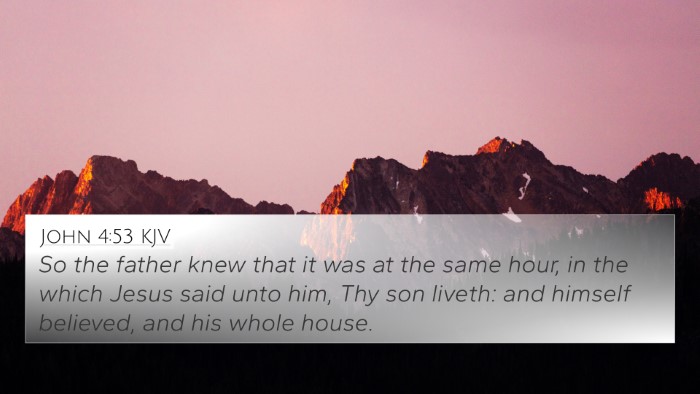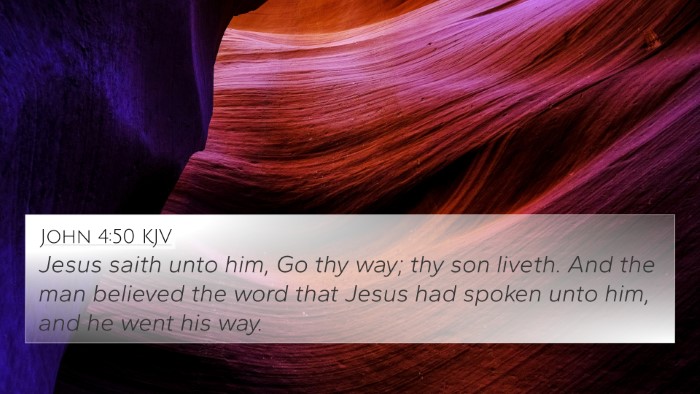Understanding John 4:51: A Summary of Insights
John 4:51 states:
“While he was yet coming down, his servants met him and told him, saying, Thy son liveth.”
This verse occurs within a narrative that focuses on the healing of a royal official's son, illustrating the power of Jesus' word and faith in His authority. Below, we analyze its meaning and implications using insights from various public domain commentaries.
Contextual Overview
In the narrative, Jesus is approached by a nobleman from Capernaum, whose son is gravely ill. The verse captures a critical moment when servants meet the nobleman as he returns home, conveying the joyous news that his son lives. This demonstrates Jesus’ authority and the faith of the nobleman.
Insights from Commentaries
-
Matthew Henry's Commentary:
Henry emphasizes the importance of faith in this passage, noting that the nobleman believed Jesus' word. This faith was demonstrated prior to seeing any evidence of healing, illustrating a theme prevalent throughout the Gospel—faith comes before sight.
-
Albert Barnes' Notes:
Barnes highlights that Jesus simply spoke healing for the child without physically coming to see him. This act of speaking signifies the power of Christ, affirming that His word alone is sufficient to enact change and healing. Barnes also points out how this reflects the nature of Christ, who transcends physical limitations.
-
Adam Clarke's Commentary:
Clarke remarks on the timing of the servants’ meeting with the nobleman, indicating that their message of life for the child came as he was 'yet coming down,' symbolizing the transition from doubt to belief. The interaction showcases how urgency in faith can lead to divine intervention.
Thematic Connections and Bible References
John 4:51 serves as a poignant example within a broader tapestry of scriptural interactions that emphasize faith and healing. The following are notable cross-references that relate to the key themes of this verse:
- Matthew 8:13: "And Jesus said unto the centurion, Go thy way; and as thou hast believed, so be it done unto thee." This verse aligns with the theme of faith healing.
- Luke 7:50: "And he said to the woman, Thy faith hath saved thee; go in peace." This verse emphasizes the importance of faith in receiving healing.
- John 11:40: "Jesus saith unto her, Said I not unto thee, that, if thou wouldest believe, thou shouldest see the glory of God?" Here, belief precedes the miraculous event, reinforcing the idea found in John 4:51.
- Mark 10:52: "And Jesus said unto him, Go thy way; thy faith hath made thee whole." This connection illustrates the continuous theme of faith leading to healing throughout the Gospels.
- Acts 3:6: "Then Peter said, Silver and gold have I none; but such as I have give I thee: In the name of Jesus Christ of Nazareth rise up and walk." This reflects the authority of Jesus' name and the action of faith.
- James 5:15: "And the prayer of faith shall save the sick, and the Lord shall raise him up." The theme of prayer and faith in healing corroborates the message of John 4:51.
- Hebrews 11:1: "Now faith is the substance of things hoped for, the evidence of things not seen." This highlights the nature of faith itself, vital for the events of John 4:51.
Conclusion
John 4:51 is not merely a historical account of healing; it serves as a powerful testament to the significance of faith in Jesus and the miraculous power of His word. As believers and seekers delve into this scripture, it inspires deeper reflection on the interconnections within Biblical texts and the profound implications of faith in their lives.
SEO Keywords Integration
This analysis incorporates important keywords for those exploring connections in scripture:
- Bible verse cross-references
- Connections between Bible verses
- Linking Bible scriptures
- Comparative Bible verse analysis
- Bible verses that relate to each other
- Cross-referencing Biblical texts
- Thematic Bible verse connections
- Bible verse parallels
- Scriptural cross-referencing
- Inter-Biblical dialogue





